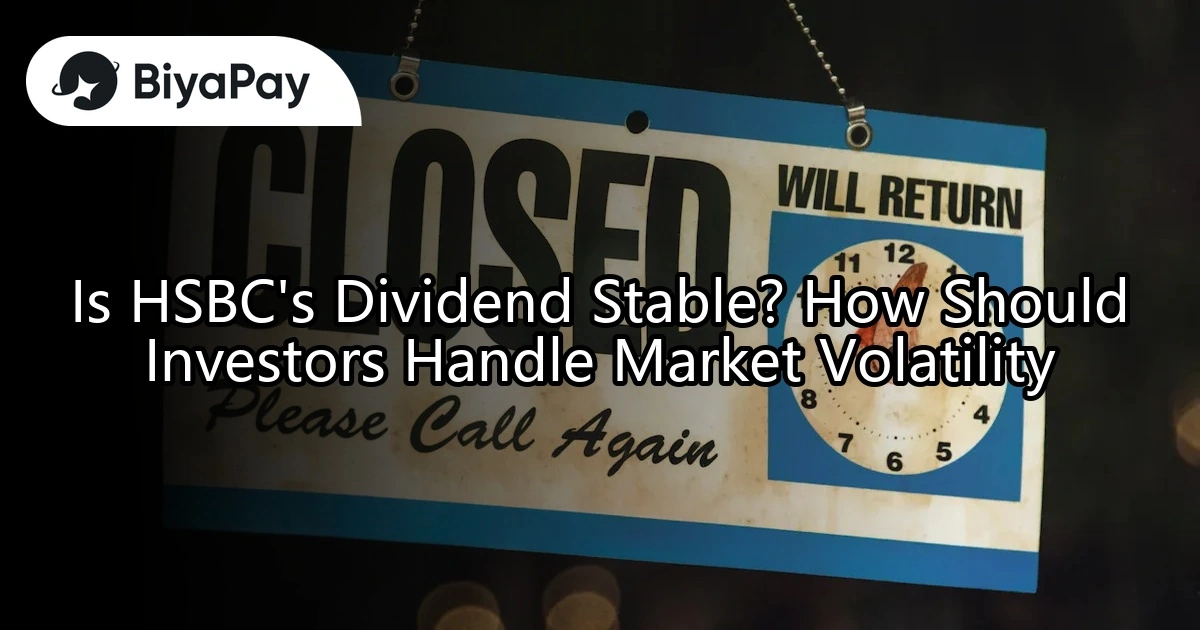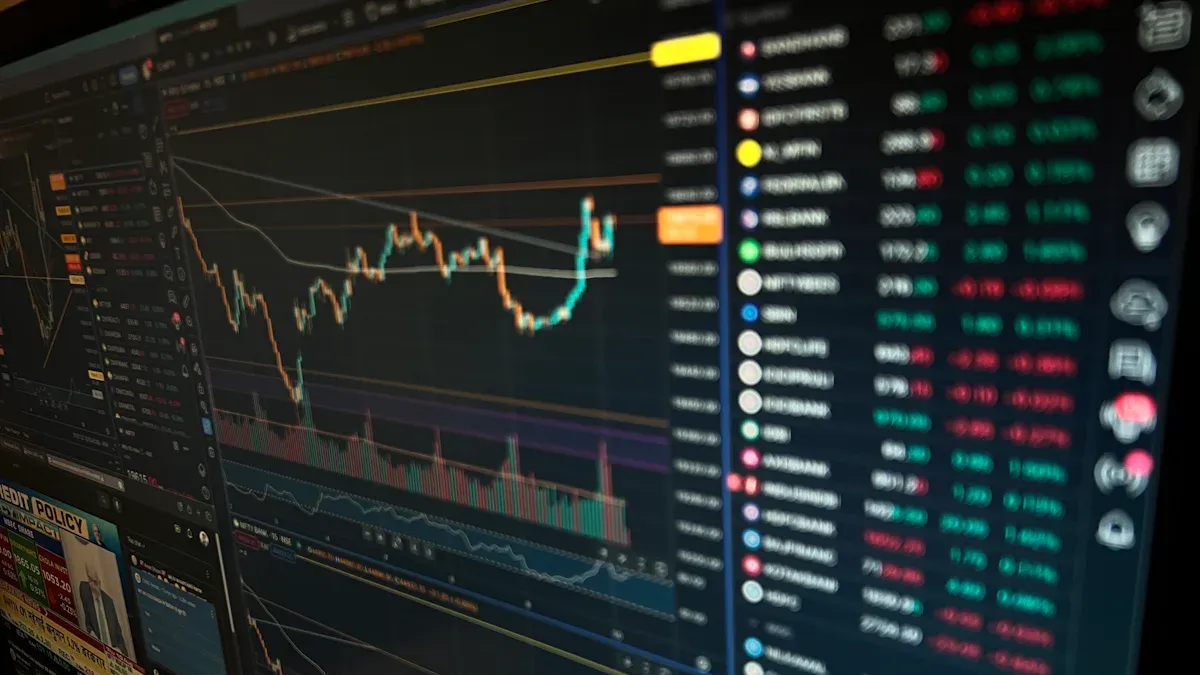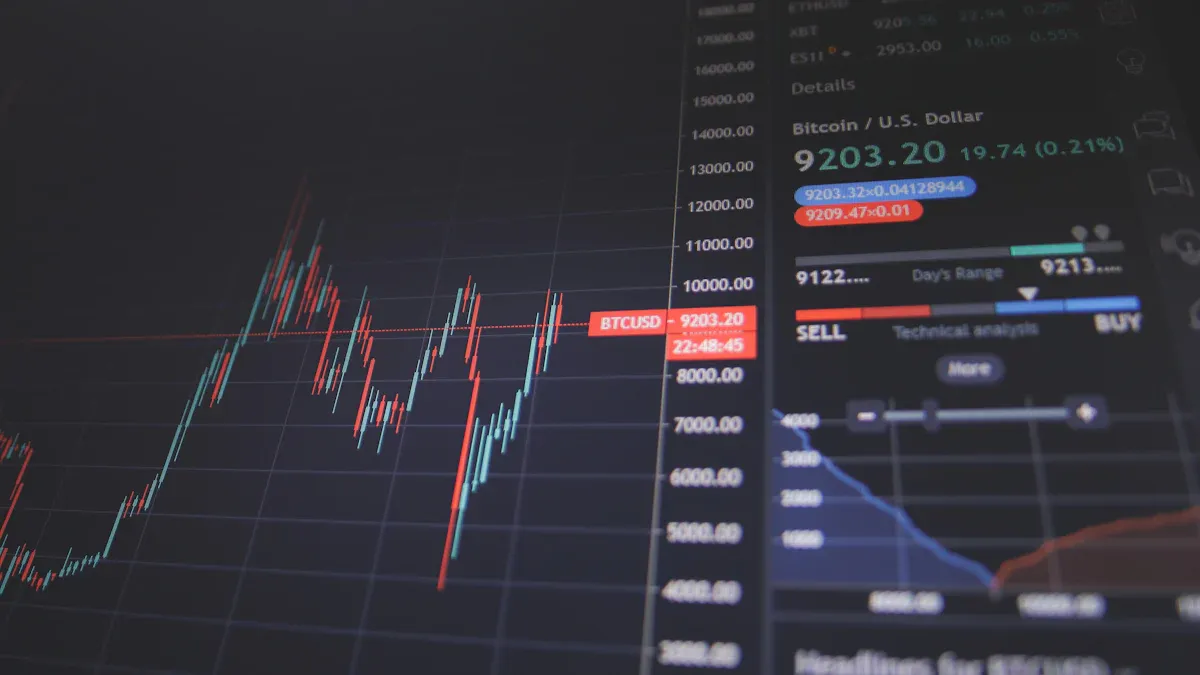- EasyCard
- Trade
- Help
- Announcement
- Academy
- SWIFT Code
- Iban Number
- Referral
- Customer Service
- Blog
- Creator
Is HSBC's Dividend Stable? How Should Investors Handle Market Volatility

Image Source: unsplash
You might be wondering, is HSBC’s dividend really stable? In fact, HSBC’s dividend performance has been quite robust in recent years. In 2014, the full-year dividend reached $0.5, and despite operational pressures, management emphasized sufficient funds to maintain the dividend policy. However, no matter how attractive the dividend, it was suspended in 2020 due to the pandemic. When pursuing stable income, you should still pay attention to market volatility and special events, and consider how to adjust your strategy to reduce risks.
Key Points
- HSBC’s past dividend performance has been stable, but special events like the pandemic may lead to suspensions, so investors need to stay aware of market and regulatory changes.
- Dividend stability is influenced by bank profitability, regulatory policies, global economy, and exchange rate fluctuations; understanding these factors helps adjust investment strategies.
- High-yield stock investments carry risks, including complex product structures, exchange rate fluctuations, and liquidity constraints, so assess your risk tolerance before investing.
- Diversifying investments, buying in batches, setting stop-profit and stop-loss points, and periodically reviewing your portfolio can effectively reduce market volatility risks and enhance income stability.
- Dividend reinvestment and long-term holding can accelerate asset growth; consider using automatic reinvestment features and sticking to a long-term investment strategy.
Current Status of HSBC’s Dividend

Image Source: unsplash
Dividend Trends
If you’ve been following HSBC’s dividends, you’ve probably noticed significant changes in recent years. From 2018 to 2019, HSBC consistently paid dividends, with an annual total of around $0.51. You would have seen that the bank paid dividends quarterly, providing investors with a stable cash flow. However, in 2020, the COVID-19 pandemic hit the global economy, and UK regulators required several banks to suspend dividends. As a result, HSBC’s dividend was halted, surprising many investors who relied on dividend income.
After the pandemic, HSBC resumed dividends in 2021 and gradually returned to a quarterly dividend schedule. In 2022 and 2023, dividend amounts steadily increased, indicating an improvement in the bank’s operations. If you’re seeking stable income, this trend might give you some reassurance.
Stability Analysis
You might ask, is HSBC’s dividend truly stable? In fact, the bank’s dividend policy adjusts based on profitability and capital conditions. Although dividend performance has been strong in recent years, the 2020 suspension serves as a reminder that no bank can guarantee perpetual dividend stability. You should know that a bank’s profitability is closely tied to the global economy, and dividend policies may change during major crises.
You can refer to the table below for a quick overview of HSBC’s dividend changes in recent years:
| Year | Total Dividend Per Share (USD) | Dividend Frequency | Remarks |
|---|---|---|---|
| 2018 | 0.51 | Quarterly | Stable dividends |
| 2019 | 0.51 | Quarterly | Stable dividends |
| 2020 | 0 | Suspended | Pandemic impact |
| 2021 | 0.35 | Resumed dividends | Lower amount |
| 2022 | 0.32 | Quarterly | Steady recovery |
| 2023 | 0.61 | Quarterly | Record high |
Small reminder: When pursuing HSBC’s dividends, you should still monitor global economic and regulatory policy changes, as these can affect dividend stability.
Key Influencing Factors
If you want to assess whether HSBC’s dividends will remain stable in the future, you can focus on a few key points:
- Bank Profitability: If HSBC maintains stable profits annually, its dividends are more likely to be secure.
- Regulatory Policies: As seen in 2020, a regulatory mandate can force banks to suspend dividends. You should keep an eye on relevant news.
- Global Economic Environment: During economic booms, bank performance typically improves, making dividends more stable. In financial crises or recessions, dividends may shrink.
- Exchange Rate Fluctuations: HSBC pays dividends in USD, so if you invest in HKD or other currencies, exchange rate changes will affect your actual returns.
If you can grasp these influencing factors, you can adjust your investment strategy more flexibly, reduce risks, and enhance income stability.
HSBC Dividend Risks
Performance Volatility
You might worry whether fluctuations in HSBC’s performance will affect its dividends. In fact, according to HSBC’s Q1 2025 financial report, the bank’s pre-tax profit grew by 11%, with an annualized return on tangible equity of 18.4%. Wealth management and transaction banking performed strongly, and the balance sheet remained robust. Management emphasized that, despite external economic uncertainties, the bank’s diversified business and structural hedges make its revenue less sensitive to interest rate changes. Market volatility has even spurred more active stock and debt trading. Overall, there’s no clear correlation between HSBC’s performance fluctuations and dividend risks. You don’t need to overly worry about significant dividend changes due to short-term performance fluctuations.
Small reminder: You should still regularly monitor financial reports and market news, as global economic and exchange rate changes can still bring uncertainties.
Dividends Not Guaranteed
When investing in HSBC’s dividends, never assume dividends are guaranteed. Although the bank has a tradition of stable dividends, special circumstances may lead to suspensions or reductions. For example, during the 2020 pandemic, regulatory requirements forced banks to suspend dividends, catching many investors off guard. You should remember that no company can promise perpetually stable dividends. Economic crises, regulatory changes, or profit declines can lead to dividend policy adjustments. When planning your income strategy, it’s best to maintain flexibility and avoid putting all your funds into a single high-yield stock.
Common Risks of High-Yield Stocks
If you want to rely on high-yield stocks for stable income, you must understand the five common risks of such products:
- Product Design Risk
Some high-yield products have complex structures, like RMB TRF, where profits are limited but losses are unlimited, leading to heavy losses for those who invest without understanding. - Exchange Rate Risk
When investing in foreign currency high-yield deposits, exchange rate fluctuations can be significant. If the USD depreciates, interest gains may be offset. - Long-Term Contract Liquidity Risk
Some long-term insurance contracts restrict withdrawals, so you may not be able to access funds immediately to respond to market or exchange rate changes. - Derivative Financial Product Volatility Risk
Products like linked bonds combine derivatives, leading to sharp price fluctuations and hard-to-manage risks. Avoid trying them if you don’t understand their structure. - Investor Knowledge Deficiency Risk
Many investors assume high-yield stocks are safe or low-risk, but they’re not. If you don’t understand the product’s nature, losses during market downturns may exceed your expectations.
It’s recommended to assess your risk tolerance and do thorough research before investing. Don’t focus only on high dividends and ignore the underlying risks.
Strategies to Handle Market Volatility

Image Source: unsplash
Diversification
To reduce risks from market volatility, diversification is one of the most effective methods. You can allocate funds across different industries, countries, or even asset classes. The benefits are clear:
- Studies from the 1960s found that holding around 20 stocks can eliminate 95% of diversifiable risk.
- Beyond 20 stocks, adding more has diminishing effects on risk reduction.
- Cross-country and cross-industry investments can further diversify risk and enhance portfolio stability.
- Stocks and bonds have low correlation, and combining them can halve your overall risk.
You don’t need to worry about a single company’s poor performance dragging down your entire portfolio. You can also consider investing in index ETFs for long-term stable average returns.
Dollar-Cost Averaging
If you’re worried about investing too much at a market peak, consider a dollar-cost averaging strategy. You can divide your planned investment into 3 to 5 batches, buying every 3 to 4 months. This averages your costs and reduces pressure from short-term volatility. Dollar-cost averaging means you don’t need to guess market highs or lows, lowering the risk of a single large investment. This approach is especially suitable for long-term investing, giving you more peace of mind.
Stop-Profit and Stop-Loss
When investing, it’s best to set stop-profit and stop-loss points in advance. When the stock price reaches your target profit, you can consider selling partially or fully to lock in gains. If the market suddenly drops beyond your tolerance, act decisively to stop losses and avoid further damage. This discipline helps control emotions and prevents impulsive decisions due to market volatility.
Small reminder: You can use mobile apps or brokerage platforms to set automatic stop-profit and stop-loss orders for convenience.
Periodic Review
After investing, don’t forget to periodically review your portfolio. You can check every six months or annually to see if your asset allocation deviates from your original goals. Periodic reviews offer several benefits:
- You can adjust investment proportions based on market changes or personal needs.
- Rebalancing strategies help sell overperforming assets and buy underperforming ones, keeping risks manageable.
- Studies show that long-term holding with periodic reviews often outperforms frequent trading.
By developing a habit of periodic reviews, you can make your investments more robust and returns more stable.
Income Strategies
Ex-Dividend Date and Payment Date
To achieve stable income, you must first understand the difference between the “ex-dividend date” and the “payment date.” The ex-dividend date is the last day you must hold the stock to qualify for the dividend. As long as you hold the stock before the ex-dividend date, you’ll receive the dividend. The payment date is when the company actually distributes the cash dividend. To optimize your income timing, it’s recommended to:
- Check HSBC’s ex-dividend and payment date announcements in advance.
- Complete your purchase before the ex-dividend date to ensure eligibility for the dividend.
- Decide whether to adjust your holdings after the payment date to avoid missing cash flow.
Small reminder: Some investors sell stocks after the ex-dividend date, but note that stock prices often drop due to the dividend payout, and short-term trading carries higher risks.
Dividend Reinvestment
If you want to grow your assets faster, dividend reinvestment is a highly effective method. You can use dividends received to buy more HSBC or other quality stocks, creating a compounding effect. Historical data shows:
- Dividend reinvestment can significantly boost compounding, shortening the time to reach your asset goals by about 7 years.
- For a $10 million goal, not reinvesting dividends could add 7 years to achieve it.
- Dividend reinvestment can increase annualized returns by about 3% or more.
- For example, with SPY, reinvesting dividends yields about 9.6% annualized returns, compared to 7.6% without reinvestment, a total return gap of over 700%.
- This strategy is especially suitable for those in the asset accumulation phase who don’t need immediate cash flow.
It’s recommended to use your broker’s automatic dividend reinvestment feature to make asset growth more efficient.
Long-Term Holding
If you’re often worried about short-term market volatility, long-term holding is the simplest and most effective strategy. By staying disciplined and avoiding frequent trading due to short-term fluctuations, you can benefit from the market’s long-term upward trend. Market experience shows:
- Market volatility is often temporary, and long-term investors can avoid emotional decisions.
- Major market drops are often followed by rebounds, and long-term holding avoids missing recovery opportunities.
- Dollar-cost averaging reduces single-point risk, supporting stable long-term returns.
- Long-term holding of high-dividend stocks is resilient during market downturns and accumulates stable income through dividends.
As long as you set clear goals and hold for over 5 years, you can typically weather short-term volatility and enjoy compounding growth.
Structured Products
If you’re seeking higher returns, you might consider HSBC’s structured investment products. However, these products carry higher risks and are suitable for those with stronger risk tolerance. According to this year’s data:
- In Q1, HSBC had 12 structured financial products that incurred losses, with losses including 10% and 5%.
- A total of 309 structured financial products failed to meet expected maximum returns in Q1, with a failure rate of 40.87%.
- Gold-linked products had the heaviest losses at 42.07%, followed by stock indices, exchange rates, and stock-linked products.
- The risk of structured products depends mainly on the performance of the underlying assets, and liquidity is also poor.
When choosing structured products, carefully assess your risk tolerance, especially for medium- to long-term products, and consult a professional financial advisor first.
When evaluating HSBC’s dividends, you should rationally consider the appeal and potential risks of high-yield stocks. According to the 2024 Investment Outlook Report, HSBC’s dividend strategy and risk management are based on the latest data and global market analysis. If you can diversify, buy in batches, periodically review, and hold long-term, according to modern portfolio theory, you can effectively enhance your portfolio’s safety and stability. It’s recommended to continuously monitor market changes and company fundamentals, flexibly apply income strategies, and make your returns more stable.
FAQ
Does HSBC’s dividend have a minimum guarantee?
There is no minimum guarantee. HSBC adjusts dividends based on profitability and regulatory requirements. You should always monitor company announcements and financial reports.
When should I buy to receive HSBC’s dividend?
You just need to hold the stock before the ex-dividend date to receive the dividend. It’s recommended to check ex-dividend date information in advance.
Are HSBC’s dividends affected by exchange rates?
Yes. HSBC pays dividends in USD. If you invest in HKD or other currencies, exchange rate fluctuations will affect your actual returns.
What are the benefits of buying HSBC stock in batches?
- Diversifies risk
- Averages costs
- Reduces pressure from one-time investments
This way, you don’t need to worry about buying at a peak.
Who is dividend reinvestment suitable for?
If you want to accumulate assets long-term and don’t need immediate cash flow, dividend reinvestment is suitable for you. It helps assets grow faster.
HSBC’s dividends are robust (0.61 USD per share in 2023), but the 2020 suspension highlights market and regulatory risks, requiring agile strategies to manage volatility and currency losses. BiyaPay empowers you with a single account for trading US/HK stocks, cryptocurrencies, and low-cost remittances. With transfer fees as low as 0.5%, BiyaPay outperforms traditional banks’ 1–2% or flat fees, offering same-day settlement to markets like Hong Kong and the US.
Convert USDT to USD or HKD at real-time rates to minimize dividend and remittance costs. Backed by FinCEN and FINTRAC licenses with instant notifications, BiyaPay ensures secure, transparent operations. Sign up in minutes to diversify investments and manage global funds. Join BiyaPay now to boost income and growth! Trade and remit with BiyaPay today to conquer market volatility!
*This article is provided for general information purposes and does not constitute legal, tax or other professional advice from BiyaPay or its subsidiaries and its affiliates, and it is not intended as a substitute for obtaining advice from a financial advisor or any other professional.
We make no representations, warranties or warranties, express or implied, as to the accuracy, completeness or timeliness of the contents of this publication.




Contact Us
Company and Team
BiyaPay Products
Customer Services
is a broker-dealer registered with the U.S. Securities and Exchange Commission (SEC) (No.: 802-127417), member of the Financial Industry Regulatory Authority (FINRA) (CRD: 325027), member of the Securities Investor Protection Corporation (SIPC), and regulated by FINRA and SEC.
registered with the US Financial Crimes Enforcement Network (FinCEN), as a Money Services Business (MSB), registration number: 31000218637349, and regulated by FinCEN.
registered as Financial Service Provider (FSP number: FSP1007221) in New Zealand, and is a member of the Financial Dispute Resolution Scheme, a New Zealand independent dispute resolution service provider.



















